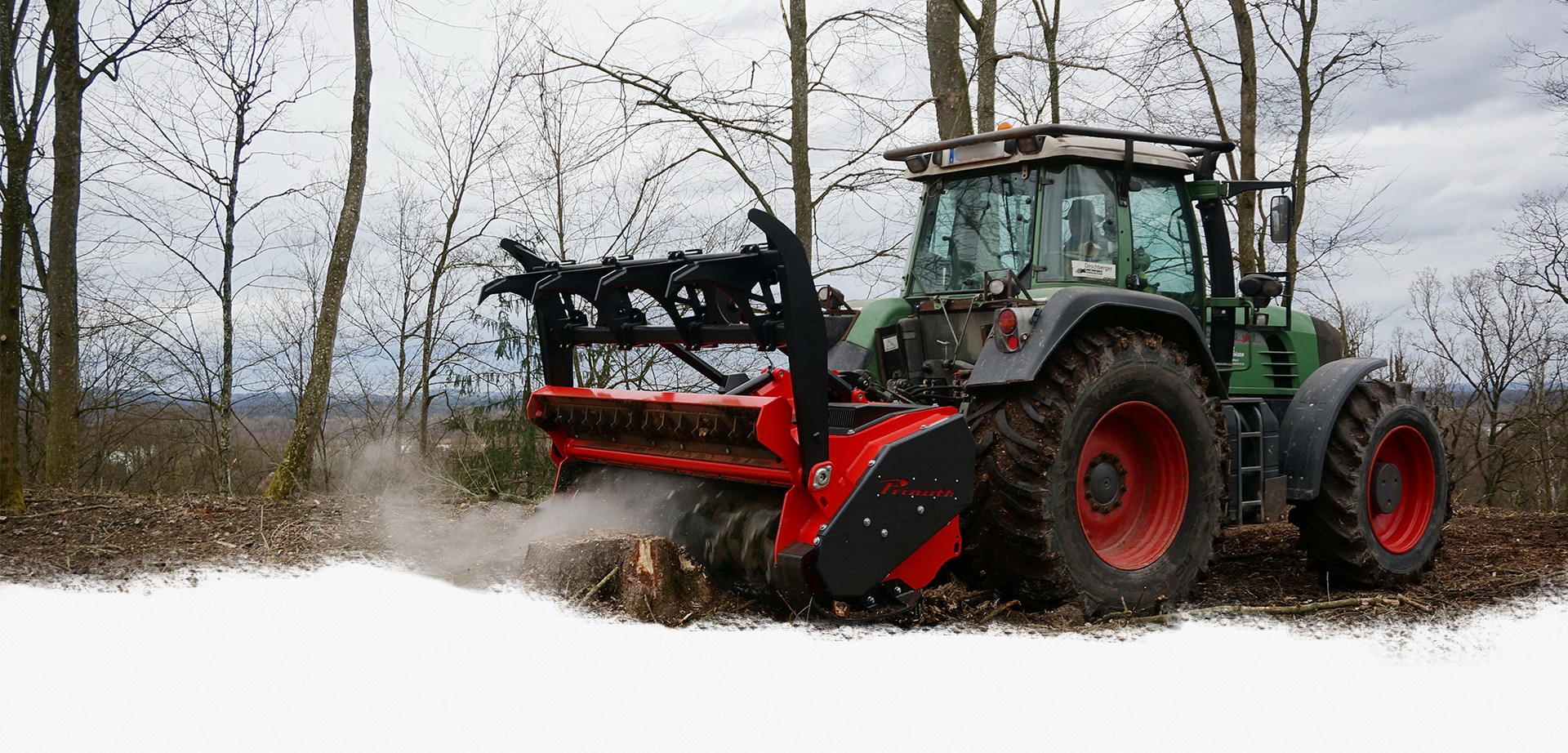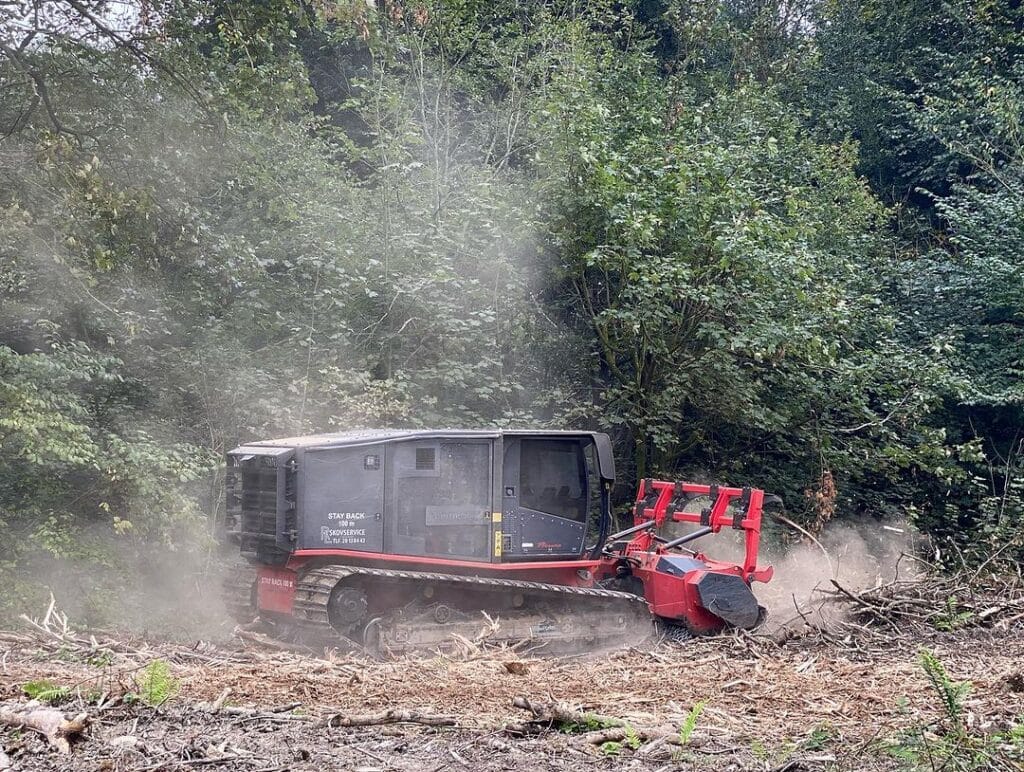M650M
The M650m is a mulcher for medium-heavy applications with a rotor diameter of 25.6 in (650 mm). It is suitable for carrier vehicles with 200 to 350 HP (version M650m TURBO up to 400 HP) and CAT III/IV.
The M650m mulcher is designed for high-performance carrier vehicles in the power class of 200 – 350 HP for 3-point hitch CAT 3 and 4. With its new UPTs rotor concept, the M650m sets new standards in shredding technology. Adaptions according to application requirements are possible due to the availability of different types of tools. A hydraulic continuously variable follow-up and protective flap provides variable adjustment of the material quality. The double-sided rotor is driven by spring tensioned power belts that run at the optimum tension. The patented synchronization control of the drive shaft (W-Kinematics) enables full dig of the mulcher at full engine speed due to the optimal drive shaft operation.
M650m TURBO
The version with patented turbo coupling is designed for carrier vehicles up to 400 hp and offers even more safety in operation. The working width of the M650m TURBO is 92 inch (2350 mm) and the rotor can be equipped with 56/72x UPTs or 68x BCS tools.
Technical Data
| Power range | 200 - 350 HP | Turbo: 200 - 400 HP |
| Overall width in mm [in] | 2500 [98) / 2800 [110] / 3000 [118] | Turbo: 2800 [110] |
| Working width in mm [in] | 2050 [81] / 2350 [92] / 2550 [100] | Turbo: 2350 [93] |
| Weight in kg* [lbs] | 2700 [5952] / 2900 [6393] / 3050 [6724] | Turbo: 3700 [8157] |
| Linkage | KAT III/IV |
| Tools | 48xUPTs / 56xUPTs | Turbo: 56/72xUPTs / 68xBCS |
Application Areas
Reclamation
Re-cultivation is the exploitation of land for economic purposes, such as plantations or agriculture. Soil preparation is a common feature of this process.
In many cases, re-cultivation is closely related with the clearance of large areas or forest clearance and also the shredding of stumps and root material. This can either involve secondary vegetation or trees. A mulcher is used to process vegetation on the surface. A rotovator is then used to deal with any remaining vegetation or stumps which are still in the ground, which are then combined with the mulched material and mixed into the soil.
Infrastructure measures
Infrastructure measures are any measures that are used to build and maintain infrastructures. Among other things, those include complete or selective clearing or land management in preparation for infrastructure construction work.
Furthermore, it also includes infrastructure maintenance and clearing around existing installations. That includes street and road construction and the expansion of rail networks or airports.
Plantation agriculture
The plantation industry involves a variety of applications. These range from forestry plantations with eucalyptus, pines and similar, to Christmas tree stands and short rotation plantations, oil palm plantations and fruit plantations such as pineapple, bananas, apples, etc.
The use of mulch technology in plantation agriculture may involve mulching all of the vegetation or just the harvest remains and root stocks. Among other things, this involves plant preparation for the next crop.
The soil is also often processed with a rotovator after mulching to also remove the tree stumps and roots in the ground. Cultivated and fertile soil performs better for new seed planting. Root stocks and harvest residues are often extremely obstructive when using machines for maintenance and harvesting. A particular feature in this area is that there are no significant alternatives to our technology for an environmentally and economically sustainable plantation industry.
Right-of-way maintenance
Line maintenance involves keeping electricity and overhead cables, underground cables, pipelines and railway lines clear. The areas which need to be kept clear are often difficult to access.
Options may be limited due to steep slopes, soft ground or rough terrain, so the areas are often cleared manually. Our products, whether tracked utility vehicles or mulchers, offer an economical alternative in such situations. Particularly in challenging terrain where our tracked utility vehicles can be the first choice.
Land clearing
The phrase “land clearing” involves a range of different applications and terms. In many cases, site clearance refers to secondary vegetation and for construction clearance. This may involve forest clearance for areas intended for use such as wind farms, parks, road construction or golf courses.
It may also include applications such as the removal of windblown timber or burnt areas, preparation work for surface mining and of equal importance, amenity areas. Site clearance can also be considered in plantations, arboretums, horticulture and landscaping.
When clearing large areas, no selective mulching takes place, as large areas or parcels with a range of different types of vegetation are processed by the mulcher. In many areas of the world, other methods are used for the same purpose, such as slash and burn, chaining or simply bulldozing the area. When these methods are used, vegetation is uprooted by bulldozers or stretched chains, and then burned or buried. In contrast to these methods, mulching is the process with the lowest degree of intervention in the ecosystem. Whether mulchers or rotorvator are used, the shredded biomass remains and greatly improves the fertility of the soil.
Extraction and access routes
Access routes are created to transport harvested timber from the forest to the respective loading areas. These tracks are usually unpaved roads which are maintained or kept available for long periods for accessing forest stands.
A conventional strategy here is to manually create these paths. However, the problems with this method include removal of timber and the issue of stumps. Mulching “disintegrates” these two problems. The chopped biomass is scattered on the ground and gives the forest soil precious added nutrients. In addition, stumps are processed and do not restrict future use of the land.
Removal of beetle-infested wood
In general, the problem starts with a few “weak” trees that are infested by pests. Over time, the infestation spreads and the damage grows. For this reason, selected trees should be removed from the forest as quickly as possible.
After felling and transporting them to the collection point, the trees are stripped and the bark is discarded or burned. Nowadays, this process is still carried out by hand in many places. Mulching is an attractive alternative, which averts the risk of the infestation spreading quickly.






